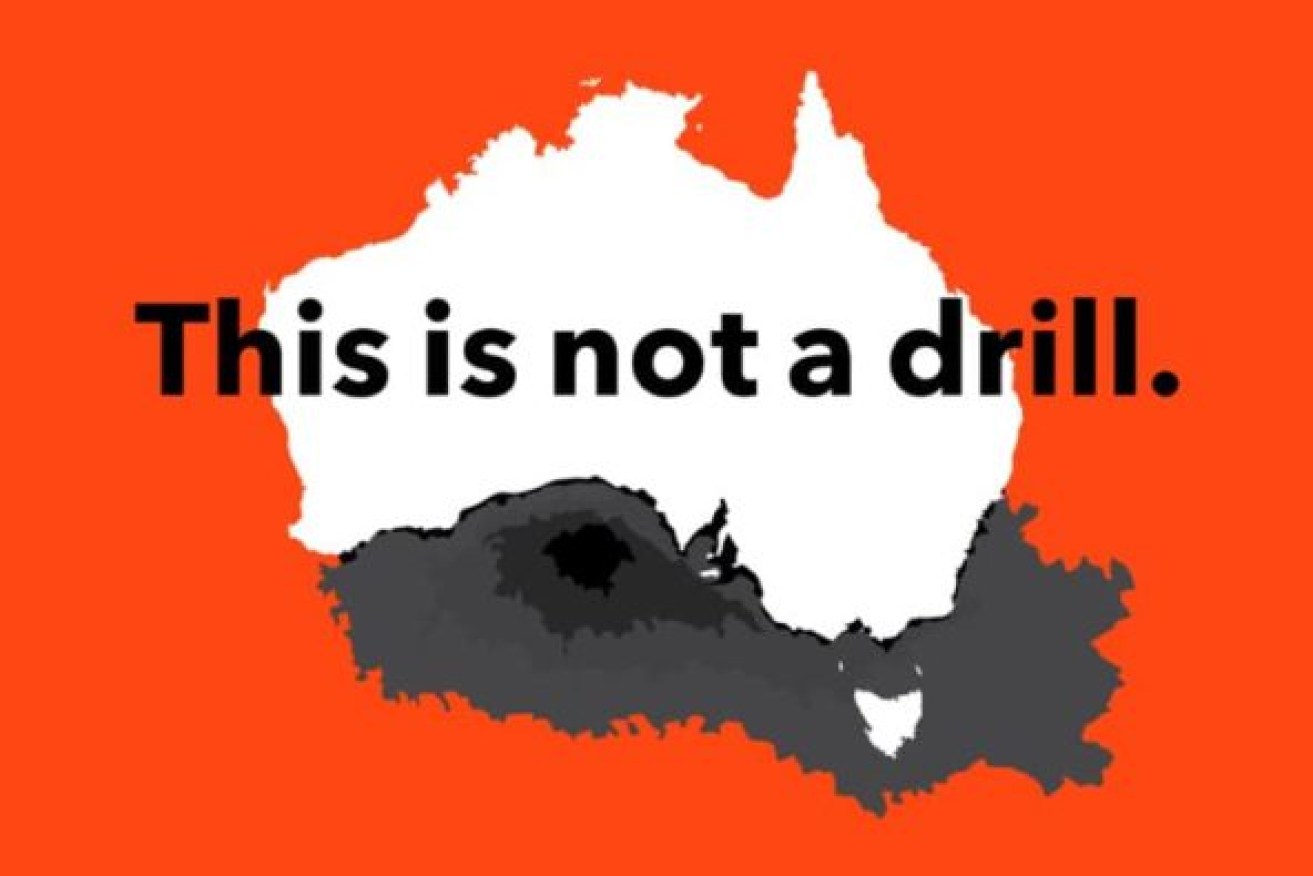Protests as oil company ‘disaster plan’ reveals risk to Australia’s coast


An image created by protestors who are demanding a plan to drill the Great Australian Bight be stopped. Patagonia/ Supplied
A foreign company is ploughing ahead with plans to drill the Great Australian Bight, prompting a public backlash amid fears of a “catastrophic” economic and environmental disaster.
Norway oil giant Equinor has been lashed by fierce opposition after its own disaster-mitigation strategy showed oil could spread across the south coast of the Australian mainland and around Tasmania if the company’s plan goes awry.
Protestors are gearing up for another “Fight for the Bight” this weekend when surfers will paddle out to sea for mass demonstrations across Victoria and South Australia.
Equinor is confident the chances of a spill are extremely low, maintaining their exploratory drilling could uncover resources and eventually create more than 1000 jobs.
Federal Resources Minister Matt Canavan has said offshore drilling was a “national priority” and exploring for oil in the Bight could help the country’s fuel security.
But critics – including independently funded think-tank The Australia Institute – said resources found in a successful operation would go offshore and there was little in the plan of benefit to the local economy.
They said it’s not worth the risk to pristine beaches, rare marine life, fishing industries and tourism, nor the climate impact of expanding a fossil fuel industry.
Mr Canavan was unavailable for interview for three days this week, and his office did not answer The New Daily‘s questions about jobs or whether the government could guarantee any resources would remain in Australia.
Further emails and calls to his spokeswoman went unanswered.
South Australian projects manager for The Australia Institute Noah Schultz-Byard said Equinor’s project could put more than 9000 jobs on the line by risking the environment upon which they rely.
“South Australians are being asked to carry all the risks while a foreign oil company comes to take all of the financial gain,” Mr Schultz-Byard told The New Daily.
“As our submission to the Senate inquiry into drilling in the Bight found, the economic benefits are minimal.”

Equinor is confident it can safely drill the Great Australian Bight to check for oil. Source: Equinor draft Environment Plan.
Equinor’s draft environment report shows that in the event of a blowout, if workers could not stop oil flowing from their exploration well 2000m deep in the ocean it would take 15 days to bring an emergency cap– a giant piece of equipment– from Singapore.

Equinor says its safety rate is improving. Source: Equinor
That could blow out to 102 days if a second cap was needed.
Latest worst-case-scenario mapping reveals that even if the company mitigated the impact of a spill, oil could still reach beaches as far as Albany in Western Australia and up the east coast to Sydney.
Sludge would cover the shores of King Island and most of Tasmania.

Kayakers and surfers unite to protest against drilling to look for oil in the Bight. Photo: Supplied.

Surfers plan to paddle out to sea at major coastal towns including Torquay and Port Lincoln as part of their protests. Photo: Supplied
Equinor said it had planned “meticulously”, and that out of 59,000 offshore wells drilled worldwide since 1980 there had been just two disasters.
One of those was BP’s 2010 Gulf of Mexico spill which killed 11 people and affected 180,000 square kilometres of ocean.
The Bight is of enormous significance to biodiversity, home to species found nowhere else on earth, and a key breeding ground for mammals including sea lions and the southern right whales which also attract tourists. The CSIRO and other researchers, backed by BP, released a report on its four-year-long research into the Bight last year .

Equinor modelling showing planning for how an oil spill could spread depending on ocean conditions. Source: Equinor’s draft Environment Plan.
Scientists involved in the project announced in November they had discovered 400 new species in the area.
Protest organiser in Port Fairy, in southwest Victoria, Ben Druitt said: “The Great Australian Bight is a unique, pristine wilderness marine environment, with 85 per cent of its marine species found only in these waters.”
Wilderness Society South Australia Director Peter Owen said Equinor was acting worse than BP, which has been among other companies to pull out of plans to drill the “magnificent” Bight.
“We’re being asked to carry an enormous risk,” Mr Owen told The New Daily.
“If things go well, they go away with the profits – if things go badly, we could be essentially wiped off the map.”
What is Equinor and what is it planning?
Equinor is an energy giant majority-owned by Norway. Since 2011, the Australian government has awarded 11 exploration permits in the Bight. If it gets regulatory approval, Equinor plans to begin its Stromlo-1 drilling at one site 370km from South Australian coast in late 2020.

Equinor’s CEO Eldar Sætre looks at his own shadow on an sign outside the company’s headquarters at Fornebu, Norway. Photo: Getty.
So, what’s in it for Australia?
Equinor said that – should they find oil or gas – jobs and an economic boost were part of the “potential benefits”. A 2018 report compiled for the Australian Petroleum Production and Exploration Association found resource discovery could support 1500 jobs in South Australia over 40 years, and another 3400 nationwide.
Supporters also point to the project as a way to help shore-up Australia’s fuel security at a time when the country is so dependent on importing almost all of its oil.
Research by The Australia Institute, however, showed the economic benefit and impact on the labour market would be minimal while the project carried great risk to tourism, aquaculture and wild fisheries. And there has been no guarantee about whether resources would stay in Australia – or how oil would be refined.
What’s next?
Equinor has opened its draft environment plan . The public has until March 20 to comment to the National Offshore Petroleum Safety and Environmental Management Authority (NOPSEMA).
Meanwhile, the Greens are pushing for World Heritage Protection for the Bight.









